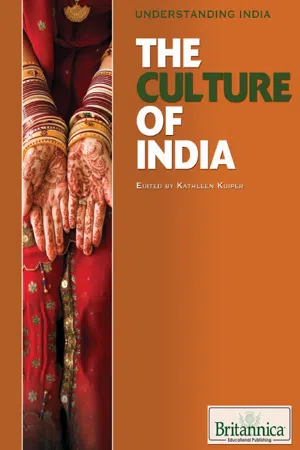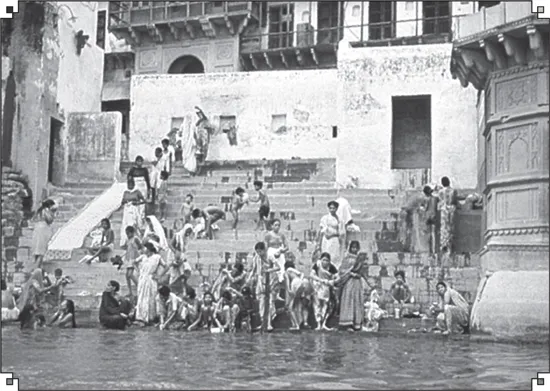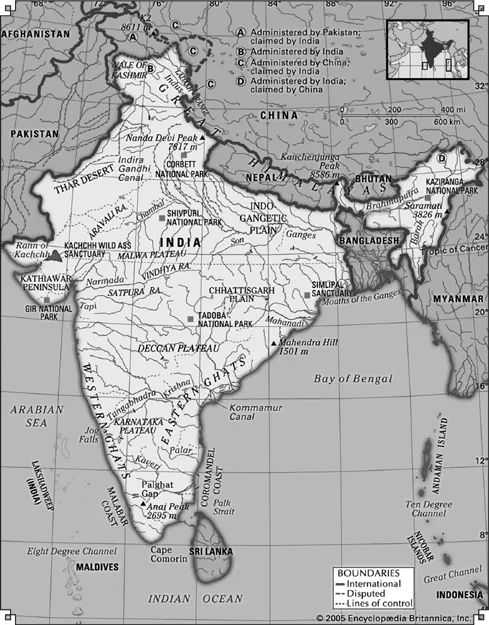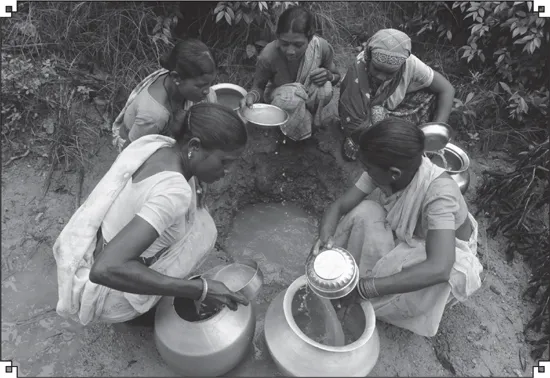
- English
- ePUB (mobile friendly)
- Available on iOS & Android
eBook - ePub
The Culture of India
About this book
Heir to a diverse array of traditions, the Indian subcontinent boasts customs that are distinguished by a constant juxtaposition of the ancient and the modern. The omnibus culture that has resulted from a rich history reflects an accommodation of ideas from across the globe and over time. This inviting narrative examines the tapestry of major events and beliefs that imbue everyday Indian life with vitality, and it presents the remarkable achievements in writing and the arts that have influenced individuals throughout the world.
Frequently asked questions
Yes, you can cancel anytime from the Subscription tab in your account settings on the Perlego website. Your subscription will stay active until the end of your current billing period. Learn how to cancel your subscription.
At the moment all of our mobile-responsive ePub books are available to download via the app. Most of our PDFs are also available to download and we're working on making the final remaining ones downloadable now. Learn more here.
Perlego offers two plans: Essential and Complete
- Essential is ideal for learners and professionals who enjoy exploring a wide range of subjects. Access the Essential Library with 800,000+ trusted titles and best-sellers across business, personal growth, and the humanities. Includes unlimited reading time and Standard Read Aloud voice.
- Complete: Perfect for advanced learners and researchers needing full, unrestricted access. Unlock 1.4M+ books across hundreds of subjects, including academic and specialized titles. The Complete Plan also includes advanced features like Premium Read Aloud and Research Assistant.
We are an online textbook subscription service, where you can get access to an entire online library for less than the price of a single book per month. With over 1 million books across 1000+ topics, we’ve got you covered! Learn more here.
Look out for the read-aloud symbol on your next book to see if you can listen to it. The read-aloud tool reads text aloud for you, highlighting the text as it is being read. You can pause it, speed it up and slow it down. Learn more here.
Yes! You can use the Perlego app on both iOS or Android devices to read anytime, anywhere — even offline. Perfect for commutes or when you’re on the go.
Please note we cannot support devices running on iOS 13 and Android 7 or earlier. Learn more about using the app.
Please note we cannot support devices running on iOS 13 and Android 7 or earlier. Learn more about using the app.
Yes, you can access The Culture of India by Britannica Educational Publishing, Kathleen Kuiper in PDF and/or ePUB format, as well as other popular books in History & Social History. We have over one million books available in our catalogue for you to explore.
Information
CHAPTER 1
THE PEOPLES OF INDIA AND THE CASTE SYSTEM

India is a diverse, multiethnic country that is home to thousands of small ethnic and tribal groups. This complexity developed from a lengthy and involved process of migration and intermarriage. The great urban culture of the vast Indus civilization, a society of the Indus River valley that is thought to have been Dravidian-speaking, thrived from roughly 2500 to 1700 BC. An early Indo-European civilization—dominated by peoples with linguistic affinities to peoples in Iran and Europe—came to occupy northwestern and then north-central India over the period from roughly 2000 to 1500 BC and subsequently spread southwestward and eastward at the expense of other indigenous groups. Despite the emergence of caste restrictions, this process was attended by intermarriage between groups that probably has continued to the present day, despite considerable opposition from peoples whose own distinctive civilizations had also evolved in early historical times. Among the documented invasions that added significantly to the Indian ethnic mix are those of Persians, Scythians, Arabs, Mongols, Turks, and Afghans. The last and politically most successful of the great invasions—namely, that from Europe—vastly altered Indian culture but had relatively little impact on India’s ethnic composition.

Ghat (stepped bathing place) on the Yamuna River at Mathura, Uttar Pradesh, India. Globe
SELECTED GROUPS
Broadly speaking, the peoples of north-central and northwestern India tend to have ethnic affinities with European and Indo-European peoples from southern Europe, the Caucasus region, and Southwest and Central Asia. In northeastern India—West Bengal (to a lesser degree), the higher reaches of the western Himalayan region, and Ladakh (in Jammu and Kashmir state)—much of the population more closely resembles peoples to the north and east, notably Tibetans and Burmans. Many aboriginal (“tribal”) peoples in the Chota Nagpur Plateau (northeastern peninsular India) have affinities to such groups as the Mon, who have long been established in mainland Southeast Asia. Much less numerous are southern groups who appear to be descended, at least in part, either from peoples of East African origin (some of whom settled in historical times on India’s western coast) or from a population commonly designated as Negrito, now represented by numerous small and widely dispersed peoples from the Andaman Islands, the Philippines, New Guinea, and other areas.

ANDAMANESE
The Andamanese, united by use of a common language, constitute the main aboriginal group of the Andaman Islands in the Bay of Bengal. Most have been absorbed into modern Indian life, but traditional culture survives among such groups as the Jarawa and Onge of the lesser islands. Late 20th-century estimates indicated approximately 50 speakers of Andamanese languages and perhaps 550 ethnic Andamanese.
Until the mid-19th century, the remoteness of these peoples and their strong territorial defenses helped them to avoid outside influences. Some of the Andamanese continue to live by hunting and collecting. The bow, once the only indigenous weapon, was used both for fishing and for hunting wild pigs; the Andamanese had no traps or fishhooks. Turtle, dugong, and fish are caught with nets and harpoons; the latter are used from single-outrigger canoes. Pottery is made, and iron, obtained from shipwrecks, has been used for arrowheads, knives, and adzes from at least the 18th century. It is shaped by breaking and grinding, a technique derived from the working of shell.
BADAGA
The largest tribal group living in the Nilgiri Hills of Tamil Nadu state in southern India, the Badaga have increased very rapidly, from fewer than 20,000 in 1871 to about 140,000 in the late 20th century. Their language is closely akin to Kannada as spoken in Karnataka state to the north of the Nilgiris. The name Badaga means “northerner,” and it is clear that the Badaga came into the Nilgiris from the north, perhaps impelled by economic or political pressures. The time of their migration has been dated sometime after the founding of the Lingayat Hindu sect in the 12th century and before 1602, when their settlement in the area was noted by Roman Catholic priests.
The Badaga were divided into six main endogamous groups that were ranked in ritual order. The two highest castes were priests and vegetarians; the lowest caste worked as servants for the other five. Traditional Badaga religion and economy also relied on goods and services supplied by the other Nilgiri peoples—Kota, Toda, and Kurumba.
The Badaga generally are agriculturists, but many are engaged in other professions. In addition to grain, Badaga farmers grow large crops of potatoes and vegetables. Many have altered their traditional practices. Improved agriculture, local and national policies, and high-caste Hindu tradition are the major concerns of the contemporary Badaga.
BHIL
The Bhil of western India are an ethnic group of nearly 2.5 million people. Many are tribal, and they have been known for rugged independence, sometimes associated with banditry.
They are distributed widely in upland areas from Ajmer in Rajasthan on the north to Thana in Maharashtra on the south, and eastward as far as Indore in Madhya Pradesh. Nearly all of them engage in agriculture, some of them using the slash-and-burn (jhum) method—in which secondary jungle is burnt and a crop is raised for one or two years in the ash—but most employing the plow. The highland Bhil generally live in scattered houses made of wattle and thatch.
The relationship between the Bhil and neighbouring peoples is not clear. The Bhil follow Rajasthani kinship usages in Rajasthan and Maharashtrian usages in Maharashtra, but with easier marriage and divorce procedures. Most Bhil worship local deities in varied pantheons only slightly touching the practices of higher Hinduism; a few aristocratic segments such as the Bhilala and some plains groups employ Brahman priests; others are converts to Islam. Their dialects are akin to Gujarati or to other Indo-Aryan languages rather than to the Munda or Dravidian tongues of most tribal peoples.
BHUTIA
The Bhutia (Bhotia, Bhote, Bhutanese) are a Himalayan people who are believed to have emigrated southward from Tibet in the 9th century or later. They constitute a majority of the population of Bhutan and form minorities in Nepal and India, particularly in the Indian state of Sikkim. They speak various languages of the Tibeto-Burman branch of the Sino-Tibetan language family.
The Bhutia are mountain dwellers, living in small villages and isolated homesteads separated by almost impassable terrain. They practice a terraced agriculture on the mountain slopes, their main crops being rice, corn (maize), and potatoes. Some of them are animal breeders, known for their cattle and yaks.
Their religion is Tibetan Buddhism, with an admixture of the pre-Buddhist shamanism known as Bon. They recognize the Dalai Lama as their spiritual leader. Their traditional society was feudal, with most of the population working as tenants of a landowning nobility, although there were few marked differences in ways of life between landowners and tenants. There were also slaves, most of them descended from captives taken in raids on Indian territory. In the 1960s the Bhutanese government formally abolished slavery and sought to break up the large estates; the nobility were also deprived of their hereditary titles.
The Bhutia trace their descent patrilineally. They are predominantly monogamous, but polygamy is still practiced in some areas.
BODO
The Bodo live in the northeastern Indian states of Assam and Meghalaya (as well as in Bangladesh) and speak Tibeto-Burman languages. They numbered about 1.5 million in the early 21st century. Dominant in Assam until about 1825, they are now the largest minority group in that state. They are concentrated in the northern areas of the Brahmaputra River valley. Most of them are settled farmers, though they formerly practiced shifting cultivation. The Bodo consist of a large number of tribes. Their western tribes include the Cutiya, Plains Kachari, Rabha, Garo, Mech, Koch, Dhimal, and Jaijong; the eastern tribes include the Dimasa (or Hill Kachari), Galong (or Gallong), Hojai, Lalung, Tippera, and Moran.
The Bodo tribes are not culturally uniform. The social system of some, such as the Garo, is matrilineal (descent traced through the maternal line), while other tribes are patrilineal. Several of the Bodo tribes were so influenced by Hindu social and religious concepts that in modern times they have regarded themselves as Hindu castes. Thus the Koch, for example, lay claim to the high Hindu status of Kshatriya (the warrior and ruling class); their claim is not generally admitted, however, and many of the subdivisions of the Koch rank very low in the caste hierarchy.
The Kachari tribe is divided into clans named after aspects of nature (e.g., heaven, earth, rivers, animals, and plants). Descent and succession to property are in the male line. They have a tribal religion, with an extensive pantheon of village and household gods. Marriage is usually arranged by the parents and involves the payment of a bride-price. Such institutions as the community house for bachelors and many features of their religion link them with the Naga and other hill tribes of Assam, but the growing influence of Hindu ideas and customs works toward assimilation into the caste society of the Assam plains.
Among the Garo, the village headman is usually the husband of the heiress, the senior woman of the landowning lineage. He transmits his headman’s office to his sister’s son, who marries the headman’s daughter (the next heiress). The lineages of the male headmen and the female heiresses are thus in perpetual alliance. Political title and land title are both transmitted matrilineally, one through one lineage, the other through the other. There are a dozen subtribes, with varying customs and dialects, but all are divided into matrilineal clans. Marriages involve members of different clans. Polygamy is practiced. A man must marry his wife’s father’s widow, who is in such cases the husband’s father’s sister, actual or classificatory. Such a wife takes precedence over her daughter, to whom the husband is already married. A man’s sister’s son, called his nokrom, stands therefore in intimate relationship to him, as the husband of one of his daughters and ultimately of his widow and the vehicle through which his family’s interest in the property of his wife is secured for the next generation, for no male can inherit property.
BOHRAS
The name Bohra (Bohora) is applied in general to any Shī‘ī Isma‘īlī Muslim of the Musta‘lī group living in western India. The name is a corruption of a Gujarati word, vahaurau, meaning “to trade.” The Bohras include, in addition to this Shī‘ī majority, often of the merchant class, a Sunnī minority who are usually peasant farmers. The Musta‘lī group, which originated in Egypt and later moved its religious centre to Yemen, gained a foothold in India through missionaries of the 11th century. After 1539, by which time the Indian community had grown quite large, the seat of the group was moved from Yemen to Sidhpur, India. A split resulted in 1588 in the Bohra community between followers of Dā’ūd ibn Quṭb Shāh and Sulaymān, who both claimed leadership of the community. The followers of Dā’ūd and Sulaymān have since remained the two major groups within the Bohras, with no significant dogmatic differences, the dā‘ī, or leader, of the Dā’ūdīs residing in Mumbai, the leader of the Sulaymānī in Yemen.
BUNDELA
The Bundelas are a Rajput clan for whom the region of Bundelkhand in north-central India is named. The Bundelas, whose origins are obscure, emerged in the 14th century. They won prominence when they resisted the Afghan emperor, Shēr Shah of Sūr, who was killed while besieging their fortress of Kalinjar in 1545. The Bundela Bir Singh of Orchha, in collusion with Akbar’s son, Prince Salim (later Jahāngīr), ambushed and killed the Mughal emperor’s confidant, Abu al-Faḍl ‘Allāmī, in 1602.
The Bundela territories were important because through them ran the route from the Deccan to the Ganges-Yamuna Doab (river basin). But they were hilly, remote, and difficult to control. The Mughals suppressed many insurrections until the Bundelas called in the Marathas (1729). After many vicissitudes the tract passed under British control in the early 19th century. The fortress of Kalinjar was taken in 1812.
GOND
The Gond are aboriginal peoples of central India, numbering about 2 million. They live in the states of Madhya Pradesh, Maharashtra, Andhra Pradesh, Bihar, and Orissa. The majority speak various and, in part, mutually unintelligible dialects of Gondi, an unwritten language of the Dravidian family. Some Gond have lost their own language and speak Hindi, Marathi, or Telugu, whichever language is dominant in their area.
There is no cultural uniformity among the Gond. The most developed are the Raj Gond, who once had an elaborate feudal order. Local rajas, linked by ties of blood or marriage to a royal house, exercised authority over groups of villages. Aside from the fortified seats of the rajas, settlements were formerly of little permanence; cultivation, even though practiced with plows and oxen, involved frequent shifting of fields and clearing of new tracts of forest land. The Raj Gond continue to stand outside the Hindu caste system, neither acknowledging the superiority of Brahmans nor feeling bound by Hindu rules such as the ban on killing cows.
The highlands of Bastar in Madhya Pradesh are the home of three important Gond tribes: the Muria, the Bisonhorn Maria, and the Hill Maria. The last, who inhabit the rugged Abujhmar Hills, are the least developed. Their traditional type of agriculture is slash-and-burn (jhum) cultivation on hill slopes. Hoes and digging sticks are still used more often than plows. The villages are periodically moved, and the commonly owned land of each clan contains several village sites occupied in rotation over the years.
Bisonhorn Maria, so called after their dance headdresses, live in less hilly country and have more permanent fields that they cultivate with plows and bullocks.
The Muria are known for their youth dormitories, or ghotul, in the framework of which the unmarried of both sexes lead a highly organized social life; they receive training in civic duties and in sexual practices.

Indian women of the Muria Gond tribe in Chhatti...
Table of contents
- Cover Page
- Title Page
- Copyright Page
- Contents
- Introduction
- Chapter 1: The Peoples of India and the Caste System
- Chapter 2: Indian Languages and Writing Systems
- Chapter 3: Hinduism
- Chapter 4: Other Indigenous Indian Religions and Indian Philosophy
- Chapter 5: Indian Visual Arts
- Chapter 6: Indian Music
- Chapter 7: Indian Performing Arts
- Chapter 8: Indian Architecture
- Conclusion
- Glossary
- For Further Reading
- Index